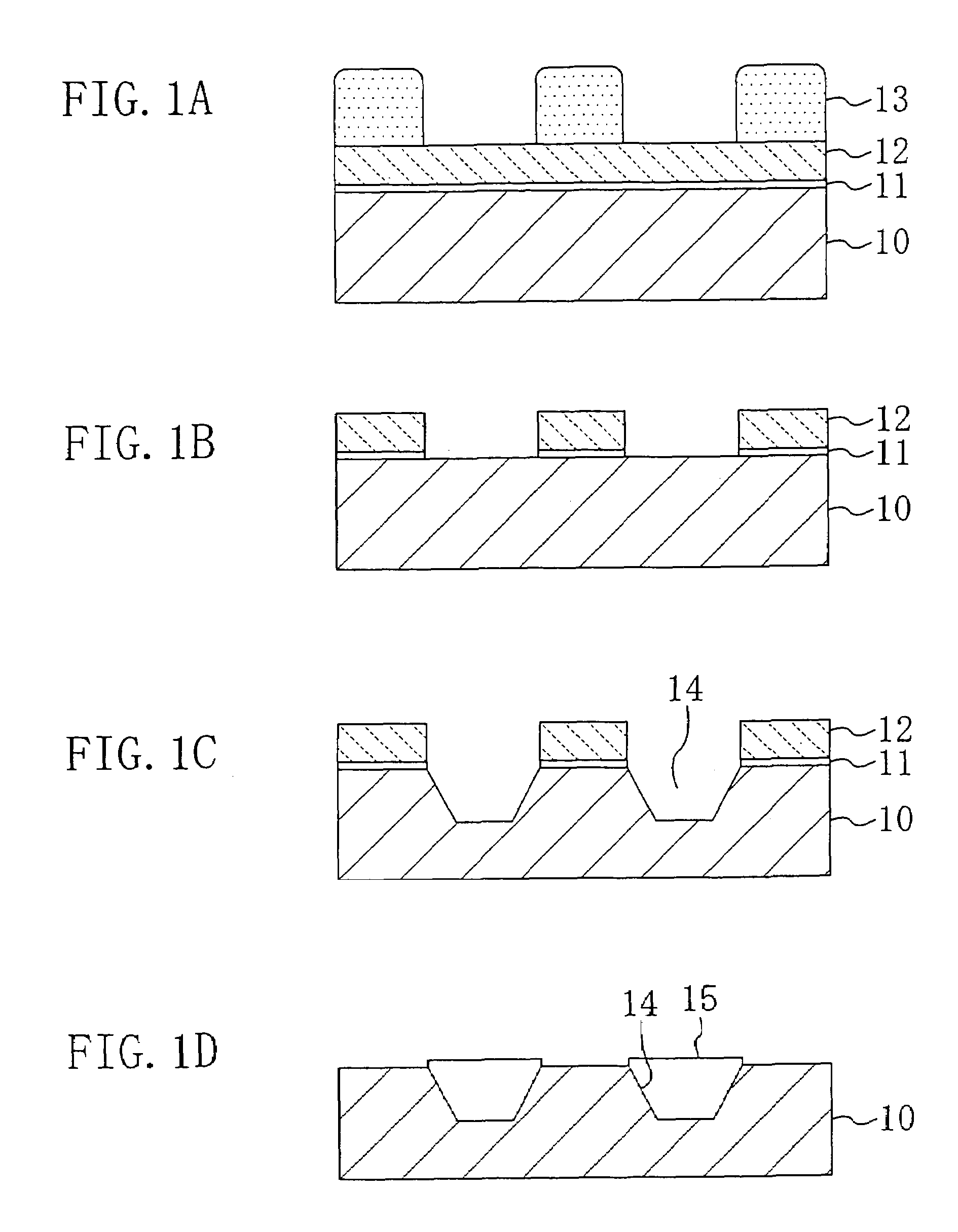Dry etching method, fabrication method for semiconductor device, and dry etching apparatus
a technology of dry etching and fabrication method, which is applied in the direction of electrical equipment, decorative arts, electric discharge tubes, etc., can solve the problems of inability to form the desired isolation depth of the trench, the difficulty of providing a sufficient active region having a sufficient size, and the degrade of the electric characteristics of the semiconductor devi
- Summary
- Abstract
- Description
- Claims
- Application Information
AI Technical Summary
Benefits of technology
Problems solved by technology
Method used
Image
Examples
embodiment 1
[0088]Referring now to the drawings, a method for fabricating a semiconductor device according to a first embodiment of the present invention will be described.
[0089]FIGS. 1A to 1D are cross-sectional views illustrating the individual process steps of the method for fabricating a semiconductor device according to the first embodiment.
[0090]First, as shown in FIG. 1A, a silicon oxide film 11 is formed on a silicon substrate 10 by, e.g., thermal oxidation, followed by a silicon nitride film 12 formed on the first silicon oxide film 11 by using a film forming method such as CVD. Then, a resist pattern 13 having openings each corresponding to a region to be formed with an isolation is formed on the silicon nitride film 12 by photolithography.
[0091]Next, as shown in FIG. 1B, dry etching is performed with respect to the silicon nitride film 12 and to the first silicon oxide film 11 by using the resist pattern 13 as a mask, thereby pattering each of the silicon nitride film 12 and the firs...
embodiment 2
[0103]A method for fabricating a semiconductor device according to a second embodiment of the present invention will be described with reference to the drawings.
[0104]FIGS. 5A to 5C are cross-sectional views illustrating the individual process steps of the method for fabricating a semiconductor device according to the second embodiment.
[0105]First, as shown in FIG. 5A, a gate insulating film 21 composed of a silicon oxide film is formed on a silicon substrate 20 by thermal oxidation, followed by a polysilicon film 22 formed on the gate insulating film 21 by using a film forming method such as CVD. Then, a resist pattern 23 covering a region to be formed with a gate electrode is formed on the polysilicon film 22 by photolithography.
[0106]Next, as shown in FIG. 5B, dry etching is performed with respect to the polysilicon film 22 masked with the resist pattern 23, thereby forming a gate electrode 24 composed of the polysilicon film 22 on the silicon substrate 20 with the gate insulatin...
embodiment 3
[0114]A method for fabricating a semiconductor device according to a third embodiment of the present invention will be described with reference to the drawings.
[0115]FIGS. 6A to 6E are cross-sectional views illustrating the individual process steps of the method for fabricating a semiconductor device according to the third embodiment.
[0116]First, as shown in FIG. 6A, a first silicon oxide film 31 is formed on a silicon substrate 30 by, e.g., thermal oxidation, followed by a silicon nitride film 32 formed on the first silicon oxide film 31 by using a film forming method such as CVD. Then, a resist pattern (not shown) having openings each corresponding to a region to be formed with an isolation is formed on the silicon nitride film 32 by photolithography. Thereafter, dry etching is performed with respect to the silicon nitride film 32 and to the first silicon oxide film 31 by using the resist pattern as a mask, thereby patterning each of the silicon nitride film 32 and the first silic...
PUM
| Property | Measurement | Unit |
|---|---|---|
| Pressure | aaaaa | aaaaa |
| Pressure | aaaaa | aaaaa |
| speed | aaaaa | aaaaa |
Abstract
Description
Claims
Application Information
 Login to View More
Login to View More - R&D
- Intellectual Property
- Life Sciences
- Materials
- Tech Scout
- Unparalleled Data Quality
- Higher Quality Content
- 60% Fewer Hallucinations
Browse by: Latest US Patents, China's latest patents, Technical Efficacy Thesaurus, Application Domain, Technology Topic, Popular Technical Reports.
© 2025 PatSnap. All rights reserved.Legal|Privacy policy|Modern Slavery Act Transparency Statement|Sitemap|About US| Contact US: help@patsnap.com



